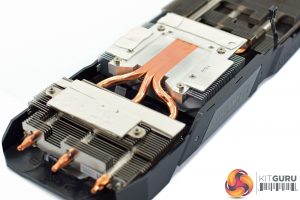The Gigabyte GTX 1660 Ti Gaming OC 6G ships in a near-identical box to the regular OC 6G, with Gigabyte's large robotic eye logo dominating the front. Three key features of the card – the RGB lighting, Windforce cooler and overclocked core – are illustrated in the bottom left corner.
As for included accessories, inside the box we find one quick start guide, and then one driver disk.
If we move on to look at the card itself, you can immediately see the design similarities between both the Gigabyte GTX 1660 Ti models we have reviewed. That's because both use matte black plastic shrouds, with just hints of grey on the front of each shroud as well. I still don't think it is a very exciting design, but at the same time it is quite inoffensive and also very colour neutral, so it would not cause any issues in a colour coordinated build.
As for the fans, there are obviously three of them – hence the ‘Windforce X3' name. Each fan measures 80mm, so they are smaller than the two 90mm fans on the OC 6G, but that has enabled Gigabyte to fit one more onto the cooler. These fans still feature Gigabyte's ‘alternate spinning' technology, too, meaning the central fan spins in reverse (clockwise) relative to the two outer fans, which Gigabyte says helps reduce turbulence and increase air pressure.
The move to a triple-fan cooling setup does mean the Gaming OC 6G is a bit larger than the other two GTX 1660 Tis we have reviewed so far – it measures 280 x 116.7 x 40.4 mm. That's quite long for a 1660 Ti, though it is still ‘only' a dual-slot thickness.
The front side of the card sports the Gigabyte logo, and this is the single RGB zone on the card which you can control using the RGB Fusion 2.0 software.
The black backplate retains the same overall look as the OC 6G, and that means it is still made out of plastic, not metal. Accordingly, it is not going to help dissipate heat from the back of the PCB, but it does help with the overall structural rigidity of the card, and I think it is also better than looking at a bare PCB.
As for the power requirements, the Gaming OC 6G still only requires a single 8-pin PCIe power connector.
Display outputs are also standard, with 1x HDMI and 3x DisplayPort connectors.
Taking the card apart is very easy, with just 6 screws that need to be removed. We can then get a look at the PCB, with Gigabyte opting for another 4+2 power phase design – the same layout as we have seen with all our GTX 1660 Ti samples so far.
Memory again comes from Micron, with the chips labelled ‘8ZA77D9WCR.' The GPU die is labelled ‘TU116-400-A1', and just a reminder that Nvidia is not pre-binning the GPUs into ‘A’ and ‘non-A’ stacks as it does with the RTX 20-series.
The Gaming OC 6G's heatsink has also been upgraded. Where the regular OC 6G has just one copper heatpipe, here we find three. There are also three separate aluminium fin stacks, while dedicated coldplates are used for VRAM and VRM cooling.
Considering the extra size and heatpipes, plus the third fan, I would expect this card to run a fair bit cooler than the OC 6G, but we will get to that part of our testing later in the review.
Be sure to check out our sponsors store EKWB here
 KitGuru KitGuru.net – Tech News | Hardware News | Hardware Reviews | IOS | Mobile | Gaming | Graphics Cards
KitGuru KitGuru.net – Tech News | Hardware News | Hardware Reviews | IOS | Mobile | Gaming | Graphics Cards


















